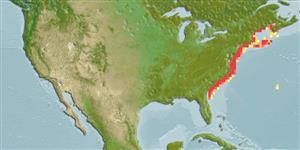分類 / Names
俗名 | 同種異名 | Catalog of Fishes(屬, 種) | ITIS | CoL | WoRMS | Cloffa
Teleostei >
Clupeiformes (Herrings) >
Alosidae (Shads and Sardines)
Etymology: Brevoortia: From James Carson Brevoort (1818-1887), studie the fauna from Ohio and South Caroline (Ref. 45335).
Environment: milieu / climate zone / depth range / distribution range
生態學
海洋; 半鹹淡水 ; pH range: 1.0 - 36.0; 海洋洄游的 (Ref. 51243); 深度上下限 0 - 50 m (Ref. 188). 亞熱帶的; ? - 26°C (Ref. 38970); 46°N - 30°N, 81°W - 64°W (Ref. 54290)
Western Atlantic: Nova Scotia, Canada southward to Indian River, Florida, USA.
西大西洋: 加拿大的新斯科舍省向南至美國佛羅里達的印地安河。
Length at first maturity / 大小 / 重量 / 年齡
Maturity: Lm 25.0, range 18 - 32 cm
Max length : 50.0 cm TL 雄魚/尚未辨別雌雄; (Ref. 188)
背棘 (總數): 0; 背的軟條 (總數): 18-24; 臀棘 0; 臀鰭軟條: 18 - 24. Upper jaw with median notch. Pelvic fin with rounded hind margin, inner fin rays equal or nearly equal to outer fin rays when fin folded back. Pre-dorsal scales modified; scales on back, above base of anal fin and at base of tail much smaller and irregularly placed. A black spot behind gill opening, followed along flank by approximately 6 lines of smaller spots (Ref. 188). Silvery, with brassy sides and a dark bluish green back (Ref. 7251).
上頜有中央的凹槽。 腹鰭有圓的後緣, 內部的鰭條等於或者幾乎等於外部的鰭條何時鰭褶背面。 前背部的鱗片修正; 鱗片背面,上方臀鰭基底鰭而在尾部的基底較小而且不規則地放置。 被跟隨的一個黑色的斑點在後鰓裂沿著側面大約較小的斑點的 6條線。 (參考文獻 188) 銀色的, 有黃銅色的側邊與一個深藍色的綠色背面.(參考文獻 7251)
Found inshore in summer, but at least some moving into deeper water in winter. Adults are found in near surface waters (Ref. 38984), usually in shallow areas overlying continental shelf, in greatest abundance immediately adjacent to major estuaries (Ref. 4639). Juveniles are also generally pelagic, with smallest size groups farthest up river (Ref. 38986). Form large and very compact schools, both of juveniles and adults. Migrate north - south; also in and out of bays and inlets. Feed by filtering phytoplankton (diatoms (Ref. 5951)) and zooplankton (small crustaceans, annelid worms and detritus (Ref. 5951)). High water temperatures apparently limit breeding. Spawn probably all year; nursery areas in estuaries. Larvae are pelagic (Ref. 38985), probably spend about a month in waters over continental shelf (Ref. 38983), entering estuarine waters at about 10 mm and larger (Ref. 844). Marketed fresh, salted, canned or smoked. Mainly used for production of oil, fertilizer and fishmeal (Ref. 188). Parasites found are isopods, copepod, cestodes and trematodes (Ref. 37032).
在夏天發現於岸邊., 但是冬天時至少一些遷進較深的水域。 成魚被發現於接近水表面 (參考文獻 38984), 通常在過度地大陸棚的水淺的區域, 在最大的豐度中緊鄰主要的河口.(參考文獻 4639) 稚魚也通常是大洋性, 魚群最小溯河最遠。 (參考文獻 38986) 形成大的與非常緊密的魚群, 稚魚與成魚都有。 迴游南北; 也在灣內中來回進出。 濾食浮游植物 (矽藻 (參考文獻 5951)) 與浮游動物。 (小型甲殼動物, 環節動物蠕蟲與碎屑 (參考文獻 5951)) 高水溫顯然地限制繁殖。 整年可能產卵; 在河口的繁殖場。 仔魚是大洋性的 (參考文獻 38985), 大約一個月可能在大陸棚 (參考文獻 38983) 上的水域中度過, 於大約 10 mm 進入河口的水域與比較大的.(參考文獻 844) 在市場上銷售新鮮的﹐鹽醃的, 將或者裝於罐頭煙燻.。 主要地用來.油,肥料與魚粉的生產。 (參考文獻 188) 發現的寄生蟲是等足目動物,橈腳類的動物,條蟲與吸蟲。 (參考文獻 37032)
Life cycle and mating behavior
成熟度 | 繁殖 | 產卵場 | 卵 | 孕卵數 | 仔魚
Breeding season apparently limited by high water temperatures (20.5°C monthly mean maximum). Spawning activity occurring almost every month in some part of the range (Ref. 2472, 39013, 844). Spawning temperature ranges from 4.4°C to 23.6°C, with peak activity at 15-18°C (Ref. 39014). Salinity ranges from 10 ppt (Ref. 39015) to usually greater than 25 ppt (Ref. 844). Fecundity observed is from 38,000 to 631,000 eggs per season (Ref. 39013).西大西洋: 加拿大的新斯科舍省向南至美國佛羅里達的印地安河。
Whitehead, P.J.P., 1985. FAO Species Catalogue. Vol. 7. Clupeoid fishes of the world (suborder Clupeoidei). An annotated and illustrated catalogue of the herrings, sardines, pilchards, sprats, shads, anchovies and wolf-herrings. FAO Fish. Synop. 125(7/1):1-303. Rome: FAO. (Ref. 188)
人類使用
漁業: 高經濟性
工具
特別的報告
下載 XML
網路資源
Estimates based on models
Preferred temperature (Ref.
123201): 7.5 - 24.4, mean 13.2 °C (based on 120 cells).
Phylogenetic diversity index (Ref.
82804): PD
50 = 0.5156 [Uniqueness, from 0.5 = low to 2.0 = high].
Bayesian length-weight: a=0.01000 (0.00534 - 0.01873), b=3.10 (2.94 - 3.26), in cm total length, based on LWR estimates for this species & Genus-body shape (Ref.
93245).
營養階層 (Ref.
69278): 3.2 ±0.2 se; based on diet studies.
Generation time: 2.8 (2.4 - 3.6) years. Estimated as median ln(3)/K based on 38
growth studies.
回復力 (Ref.
120179): 中等的, 族群倍增時間最少 1.4 - 4.4年 (K=0.4; tm=1-3; Fec=38,000).
Prior r = 0.31, 95% CL = 0.20 - 0.46, Based on 1 stock assessment.
Fishing Vulnerability (Ref.
59153): Low to moderate vulnerability (30 of 100).
Climate Vulnerability (Ref.
125649): Moderate vulnerability (45 of 100).
Nutrients (Ref.
124155): Calcium = 87.7 [51.9, 140.0] mg/100g; Iron = 1.45 [0.83, 2.30] mg/100g; Protein = 20 [19, 21] %; Omega3 = 0.58 [0.35, 0.93] g/100g; Selenium = 21.6 [11.4, 40.2] μg/100g; VitaminA = 8.6 [3.6, 21.0] μg/100g; Zinc = 0.964 [0.676, 1.343] mg/100g (wet weight);
